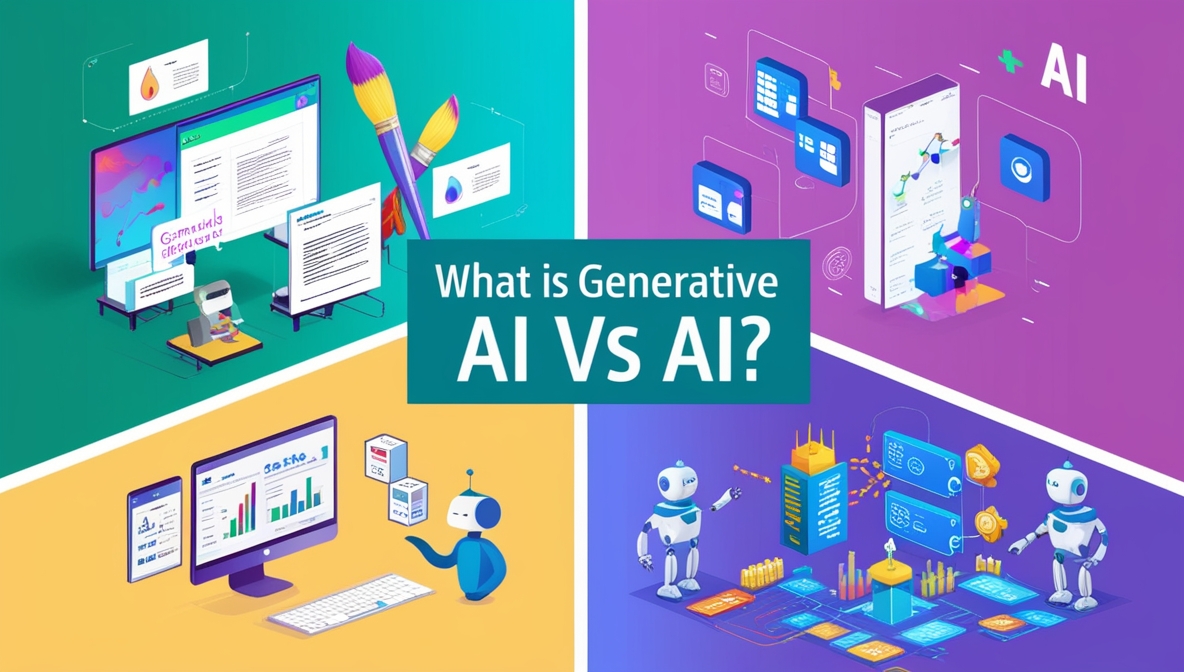Generative AI is a special type of artificial intelligence that creates new content like images, music, or text. It uses complex algorithms to produce things that didn’t exist before. On the other hand, AI is a broader term that covers any technology that makes machines act smart.
This includes systems that learn, solve problems, or make decisions based on data.
In this article, we are going to discuss what is Generative AI vs AI. We will explore how they are different and what makes each one special in the world of technology.
What is Traditional AI?
Traditional AI refers to systems designed to carry out specific tasks by processing data and making decisions based on algorithms. These systems are trained to follow predefined rules or learn from data using statistical methods. Traditional AI is primarily focused on analyzing existing information and solving problems within a set framework. Some examples include:
- Chatbots: Respond to user queries with scripted or rule-based responses.
- Spam Filters: Identify and block unwanted emails.
- Recommendation Systems: Suggest products or content based on user behavior.
In essence, traditional AI mimics human decision-making but is constrained by the rules or data it’s given.
What is Generative AI?
Generative AI, on the other hand, is a subset of AI designed to create new content, such as images, text, music, or even video, that didn’t exist before. Unlike traditional AI, which analyzes and acts based on existing data, generative AI uses models like Generative Adversarial Networks (GANs) and Transformers to generate new data.
For example, OpenAI’s GPT-3 can write human-like text based on a few prompts, while DALL-E generates images from text descriptions. Generative AI is widely used in creative industries, product design, and more, where innovation and novelty are key.
Key Differences Between Generative AI and Traditional AI
| Aspect | Generative AI | Traditional AI |
| Purpose | Creates new data (images, text, music) | Analyzes and processes existing data |
| Example Technologies | GPT-3, DALL-E, GANs, Deepfake | Machine Learning, Chatbots, Spam Filters |
| Approach | Uses neural networks to generate content | Uses algorithms and rules to process data |
| Output | New, unique content | Data analysis, decision-making, predictions |
| Creativity | High – AI can create novel and original content | Low – AI works within predefined rules and frameworks |
Real-World Applications
Generative AI
- Content Creation: Tools like GPT-3 are being used by writers, marketers, and businesses to automatically generate articles, blogs, and advertisements.
- Art and Design: DALL-E and other AI-based design tools are allowing artists to create unique, custom illustrations based on text prompts.
- Gaming: Generative AI is being used to develop procedurally generated landscapes and characters in games, providing endless variation.
- Music Production: Platforms like OpenAI’s MuseNet generate unique music compositions, assisting musicians in creating new pieces.
Traditional AI
- Healthcare: AI is used for diagnosing diseases by analyzing medical images or patient data.
- Customer Service: Chatbots and virtual assistants help businesses provide customer support and answer frequently asked questions.
- Finance: AI models predict market trends, detect fraudulent activity, and assist in trading.
- E-commerce: AI is used in recommendation systems to suggest products to customers based on previous purchases or browsing history.
How These AIs Are Changing Industries?
- Generative AI in Healthcare: According to a report from Accenture, AI-driven technologies like Generative AI could help the healthcare industry save up to $150 billion annually by 2026. This is due to the ability of AI systems to generate innovative drug designs and medical imaging techniques.
- Traditional AI in E-commerce: Forrester projects that by 2025, 72% of e-commerce companies will be using AI for personalized shopping experiences, boosting sales and customer retention.
- Generative AI in Entertainment: According to Deloitte, generative AI is expected to reshape the media industry, with AI-generated content becoming increasingly mainstream in film production, gaming, and social media content creation.
Why Does This Matter?
Understanding the differences between generative AI and traditional AI is essential because it determines how businesses and individuals can harness the power of AI to meet their needs. Generative AI is particularly useful for creative tasks, innovation, and the generation of new content, while traditional AI excels in data analysis, decision-making, and process automation.
By recognizing these distinctions, companies can leverage the right AI tools for specific challenges, whether it’s improving operational efficiency with traditional AI or driving creative innovation with generative AI.
FAQs
What is Generative AI?
Generative AI is a type of artificial intelligence that creates new content, such as images, text, or music, based on learned patterns.
What is AI in general terms?
AI (Artificial Intelligence) is the broad field of technology that enables machines to mimic human-like cognitive functions.
How is Generative AI different from traditional AI?
Generative AI focuses on creating new data, while traditional AI typically analyzes and processes existing data for decision-making.
Can AI and Generative AI be used together?
Yes, they can complement each other, with traditional AI analyzing data and generative AI producing creative outputs based on that analysis.
Conclusion
Generative AI and traditional AI serve different purposes in the tech world. While traditional AI is focused on analyzing existing data and making decisions, generative AI is all about creating new content, such as images, music, and text, that didn’t exist before.
Each type of AI brings unique value to different industries. Understanding their differences helps businesses choose the right AI tool for tasks like improving efficiency or driving creativity. Both are powerful, but their applications depend on the specific needs of a project.
P.S.: If you’re interested, discover appealing fonts to enhance your content with our Font Generator!
